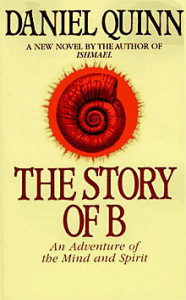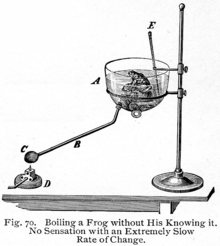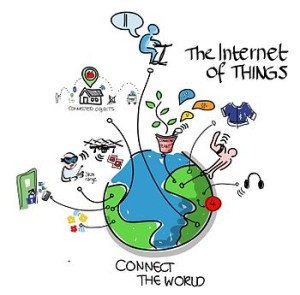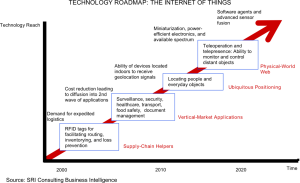If you drop a frog in a pot of boiling water, it will of course frantically try to clamber out. But if you place it gently in a pot of tepid water and turn the heat on low, it will float there quite placidly. As the water gradually heats up, the frog will sink into a tranquil stupor, exactly like one of us in a hot bath, and before long, with a smile on its face, it will unresistingly allow itself to be boiled to death.
WiKi︰煮蛙效應源自美國康奈爾大學的科學家做過的一個溫水煮蛙實驗:將一隻青蛙放進沸水中,青蛙一碰沸騰的熱水會立即奮力一躍從鍋中跳出逃生;又嘗試把這只青蛙放進裝有冷水的鍋裡,青蛙如常在水中暢游,然後慢慢將鍋裡的水加溫,直到水燙得無法忍受時,青蛙再想躍出水面逃離危險的環境卻已四肢無力,最終死在熱水中。[來源請求]實驗說明的是由於對漸變的適應性和習慣性,失去了警惕和反抗力的道理。此實驗現已成為大眾傳播媒體廣泛應用的寓言。
假使親眼『所見』和『所聞』也不能『相信』,那麼又該『相信』什麼呢?如果『所信』之『指南針』壞了,『方向』的『意義』又是『什麼呢』??只不過『認識自己』與『驗證真相』並非簡單的事!!為什麼呢?試問又誰會搞錯『伊索寓言』與『現象事實』之區分的呢??或許說『人就是會犯錯』的吧!!
彷彿蘇東坡曾講之『想當然爾』,因而方有『得心應手』成語的吧;又好像莊子之『庖丁解牛』,藉著『熟能生巧』之故,不是才能『得之於手,應之於心』的嗎??
□︰樹莓派基金會 RPI 2 為什麼要被微軟煮青蛙的呢?
○︰你是說視窗十嗎?也有 SNAPPY Ubuntu Core 的吧!
□︰問題是,這樣學 linux 的人就會減少!
○︰那不是 Desktop 耶!只是個命令列 IoT 平台吧!
□︰是嗎??
○︰或許□該仔細讀讀
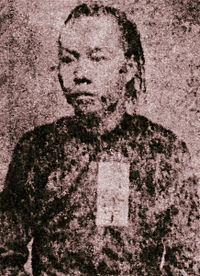
廖添丁生於,清帝國臺灣道臺灣府大肚上堡秀水庄
死於,1910年11月18日(27歲)日治臺灣
《 Windows 10 for Raspberry Pi 2 》,特別注意授權乙事
《 MICROSOFT PRE-RELEASE SOFTWARE LICENSE TERMS 》
MICROSOFT WINDOWS FOR WINDOWS DEVELOPER PROGRAM FOR IOT
。即使是說『 Snappy Ubuntu 』,大概也都算不得 Linux 的世界裡《 盜亦有道? 》之『廖添丁』的吧!而今『 IoT 』 Internet of Things 一事,天下沸騰,既然都在鍋裡,說什麼『誰煮誰』的呢!不如『煮酒論英雄』,看看『倚天』鬥『屠龍』大戲好點。
□︰…… 天下沒有白吃的午餐……!!!
○︰恰好回味一段《觀測之『觀人文』》︰
十九世紀時義大利的 Vilfredo Pareto 是『精英理論』的創始人,他經過多年的觀察,歸結出
20% 的人口擁有 80% 的財產
……
有些人相信有一種『無辜者』的理論,解釋著自己的『不得已』,說明不知道這會『變那樣』;也許只是不想知道『彼此抉擇』是『息息相關』的事實。對此也只能無可奈何罷了!!還有些人更創造了一種所謂的『欺負理論』︰
『人文』社會不過是『包裝了』的
有的欺負沒有的
知道的欺負不知道的
能的會的欺負不會不能的
說不定『樹莓派基金會』的創始者,正想激發更多的『廖添丁們』的哩!!
Technology Roadmap: Internet of Things
MQTT is a machine-to-machine (M2M)/”Internet of Things” connectivity protocol. It was designed as an extremely lightweight publish/subscribe messaging transport. It is useful for connections with remote locations where a small code footprint is required and/or network bandwidth is at a premium.
那個『 IoT 』現今有個大名叫做『物聯網』。這一想法是怎麼來的呢?根據創造這個詞的作者 Kevin Ashton 在《物聯網那回事 ── 在真實世界裡,東西比理念要緊 ── 》一文中所講︰
The fact that I was probably the first person to say “Internet of Things” doesn’t give me any right to control how others use the phrase. But what I meant, and still mean, is this: Today computers—and, therefore, the Internet—are almost wholly dependent on human beings for information. Nearly all of the roughly 50 petabytes (a petabyte is 1,024 terabytes) of data available on the Internet were first captured and created by human beings—by typing, pressing a record button, taking a digital picture or scanning a bar code. Conventional diagrams of the Internet include servers and routers and so on, but they leave out the most numerous and important routers of all: people. The problem is, people have limited time, attention and accuracy—all of which means they are not very good at capturing data about things in the real world.
─── ☆︰ I gOt iT,終於可以照顧遠方的『玫瑰花』了。 ───
